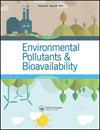Hazardous elements speciation in sandy, alkaline coal mine overburden by using different sequential extraction procedures
Q3 Chemical Engineering
引用次数: 2
Abstract
Abstract This paper deals with the problem of hazardous elements (HE) speciation in sandy, alkaline coal mine overburden destined for restoration. Two sequential extraction procedures [five stages Tesier’s (T) and seven stages Zeien and Brümmner’s method (ZB)] were employed that focused on potentially bioavailable HE fractions previously found in plants growing during this soil restoration process. The results showed that the selection of the extraction procedure in HE speciation is essential, due to the different potential threats of HE fractions obtained for plants. The biggest residual fraction obtained by both extractions suggest geogenic origin of Cu, Zn, Ni, Cr and Pb. Tesier’s extraction procedure works reasonably well for low concentration of water soluble and exchangeable HEs, whilst giving higher values for their organically bound forms. Zeien and Brümmner’s method, however, was found to be more appropriate for evaluation of the mobility of HE as Mn and Fe oxide fractions. The principal component analysis test estimated three main groups where the relationship between soil properties (pH, clay and silt), total content of element and available fractions (Zn, Ni, Cr, Pb-T and Ni-ZB) was defined as a PC 1 group. Other PC 2 and PC 3 from the PCA analysis include Corg and CEC, and available Cu-T and Cr, Pb-ZB, respectively. The PC 3 factor linked fine sand and available Zn-ZB. Pearson’s correlation coefficients showed a high correlation between available HE and high pH(KCl) obtained by T-extraction, and Ni by Zn-extraction. Also, clay, silt and fine sand were highly correlated with the Ni-ZB available forms.砂质碱性煤矿覆盖层中不同顺序提取方法对有害元素形态的影响
摘要本文研究了沙质碱性煤矿修复覆盖层中有害元素(HE)形态问题。采用了两个顺序提取程序[五个阶段Tesier (T)和七个阶段Zeien和br mmner的方法(ZB)],重点是在土壤恢复过程中生长的植物中先前发现的潜在生物可利用的HE组分。结果表明,由于所获得的HE组分对植物的潜在威胁不同,在HE形成过程中提取工艺的选择至关重要。两种提取方法获得的最大残余分数表明Cu、Zn、Ni、Cr和Pb的成因。Tesier的提取方法对低浓度的水溶性和交换性he相当有效,同时对其有机结合形式给出更高的值。然而,Zeien和br mmner的方法被发现更适合于评价HE作为Mn和Fe氧化物组分的迁移率。主成分分析试验估计了三个主要组,其中土壤性质(pH、粘土和淤泥)、元素总含量和有效组分(Zn、Ni、Cr、Pb-T和Ni- zb)之间的关系被定义为pc1组。PCA分析的其他pc2和pc3分别包括Corg和CEC,以及可用的Cu-T和Cr, Pb-ZB。pc3因子将细砂与有效锌锌结合起来。Pearson相关系数表明,有效HE与t萃取得到的高pH值(KCl)和zn萃取得到的Ni之间存在较高的相关性。粘土、粉砂和细砂与Ni-ZB有效形态高度相关。
本文章由计算机程序翻译,如有差异,请以英文原文为准。
求助全文
约1分钟内获得全文
求助全文
来源期刊
CiteScore
1.62
自引率
0.00%
发文量
0
审稿时长
1 months
期刊介绍:
Chemical Speciation & Bioavailability ( CS&B) is a scholarly, peer-reviewed forum for insights on the chemical aspects of occurrence, distribution, transport, transformation, transfer, fate, and effects of substances in the environment and biota, and their impacts on the uptake of the substances by living organisms. Substances of interests include both beneficial and toxic ones, especially nutrients, heavy metals, persistent organic pollutants, and emerging contaminants, such as engineered nanomaterials, as well as pharmaceuticals and personal-care products as pollutants. It is the aim of this Journal to develop an international community of experienced colleagues to promote the research, discussion, review, and spread of information on chemical speciation and bioavailability, which is a topic of interest to researchers in many disciplines, including environmental, chemical, biological, food, medical, toxicology, and health sciences.
Key themes in the scope of the Journal include, but are not limited to, the following “6Ms”:
Methods for speciation analysis and the evaluation of bioavailability, especially the development, validation, and application of novel methods and techniques.
Media that sustain the processes of release, distribution, transformation, and transfer of chemical speciation; of particular interest are emerging contaminants, such as engineered nanomaterials, pharmaceuticals, and personal-care products.
Mobility of substance species in environment and biota, either spatially or temporally.
Matters that influence the chemical speciation and bioavailability, mainly environmentally relevant conditions.
Mechanisms that govern the transport, transformation, transfer, and fate of chemical speciation in the environment, and the biouptake of substances.
Models for the simulation of chemical speciation and bioavailability, and for the prediction of toxicity.
Chemical Speciation & Bioavailability is a fully open access journal. This means all submitted articles will, if accepted, be available for anyone to read, anywhere, at any time. immediately on publication. There are no charges for submission to this journal.

 求助内容:
求助内容: 应助结果提醒方式:
应助结果提醒方式:


